Last updated on February 13, 2024

Underground Sea | Illustration by Rob Alexander
House Dimir is the most secretive of the 10 Ravnica Guilds – so secretive that the majority of Ravnica's population thought that there were nine guilds in total, and most of the few who had heard about the tenth dismissed it as a myth.
Masters of disguise, misdirection, and disinformation, the guild provides assassination services that they carry out with perfect planning and flawless execution.
Depending on the plane they come from, cards sometimes lack the ruthless elegance that is House Dimir's signature. In today's ranking, we'll find horrors, nightmares, and zombies that prefer brute force to an assassin's finesse. But at any rate, the best cards are always about getting the upper hand and ruthlessly extracting an advantage.
Let's check the best of the best, and find what the Dimir colors have to offer!
What Are Dimir Cards in MTG?
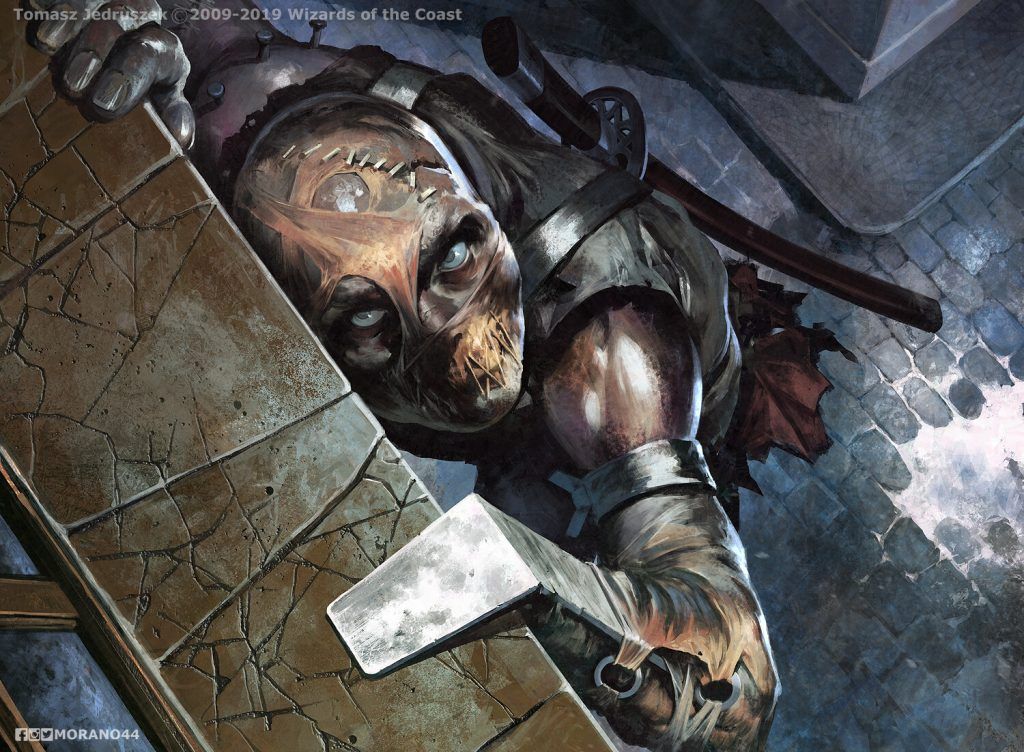
Fallen Shinobi | Illustration by Tomasz Jedruszek
In Magic: The Gathering, Dimir cards are those that include blue and black in their casting cost, like Baleful Strix. “Dimir” is one of the 10 guilds from Ravnica, each associated with a color pair. Since the guilds' introduction in Ravnica: City of Guilds, their names became the official designation for the color pair that each represents.
Specifically for the Commander format, Dimir cards have a wider definition: They are cards with a color identity. When considering both their cost and their rules text, they include both the and mana symbols, but no others. There aren’t many differences between both definitions, but cards such as Rona's Vortex have an identity for EDH purposes.
In this ranking, we'll stick strictly with color identity. There are of course many amazing black, blue, or colorless cards that you can include in a deck, but we won't include them here.
On the other hand, since we're talking about all cards we'll include lands – they may not be as flashy as spells, but if we’re talking about Dimir cards we need Dimir lands to power them up.
#43. Thief of Sanity
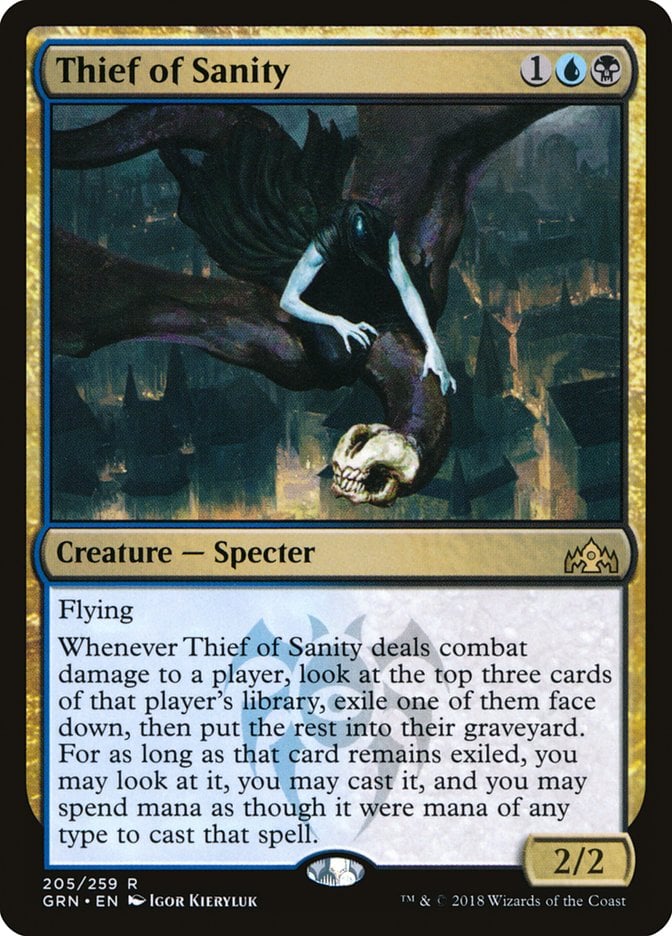
Thief of Sanity is a good example of Dimir tools and methods: an evasive flier that provides an incremental advantage while pilfering from our foe's library.
When Thief of Sanity deals combat damage to a player, we can look at the top three cards of our opponent's library and put one of them into exile face down and the others into their graveyard. Adding larceny to milling, we get to cast the exiled card spending mana of any type, and we can do so even if Thief of Sanity leaves the battlefield or leaves our control.
#42. Dismal Backwater

Dismal Backwater is dirt-cheap (just a few cents) and gets the job done as a Dimir land plus a tiny bit of life gain – this land will never be the star of the show, but even stars need a solid supporting cast!
#41. Mnemonic Betrayal
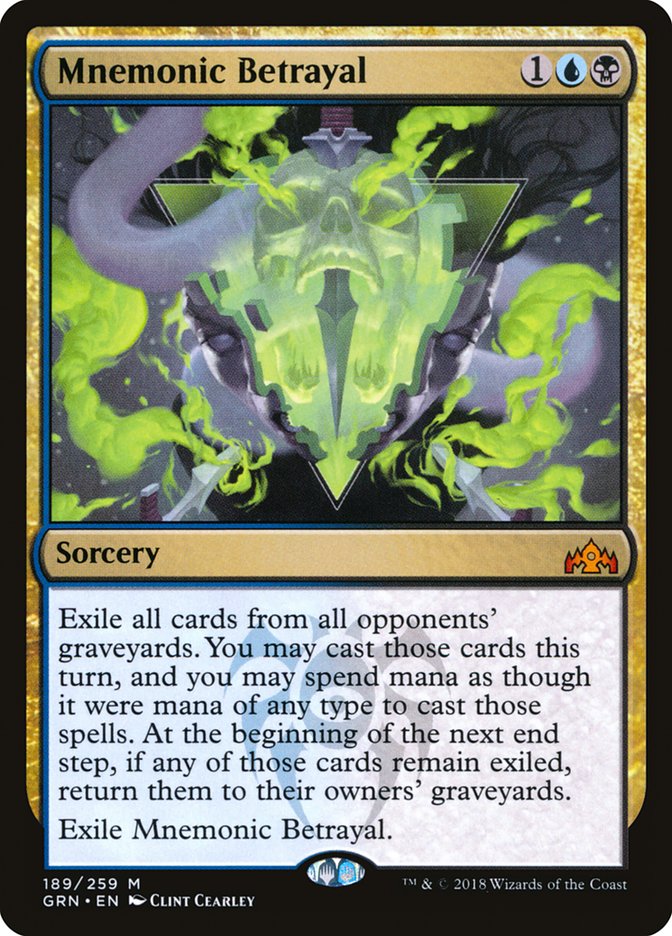
Quite often seen serving under Tasha, the Witch Queen‘s command, Mnemonic Betrayal offers a “what's yours is actually mine” effect similar to Thief of Sanity, but without the need to deal combat damage.
Mnemonic Betrayal pilfers from all graveyards. You only have until the next end step to cash in on your ill-gotten gains, though.
#40. Creeping Tar Pit
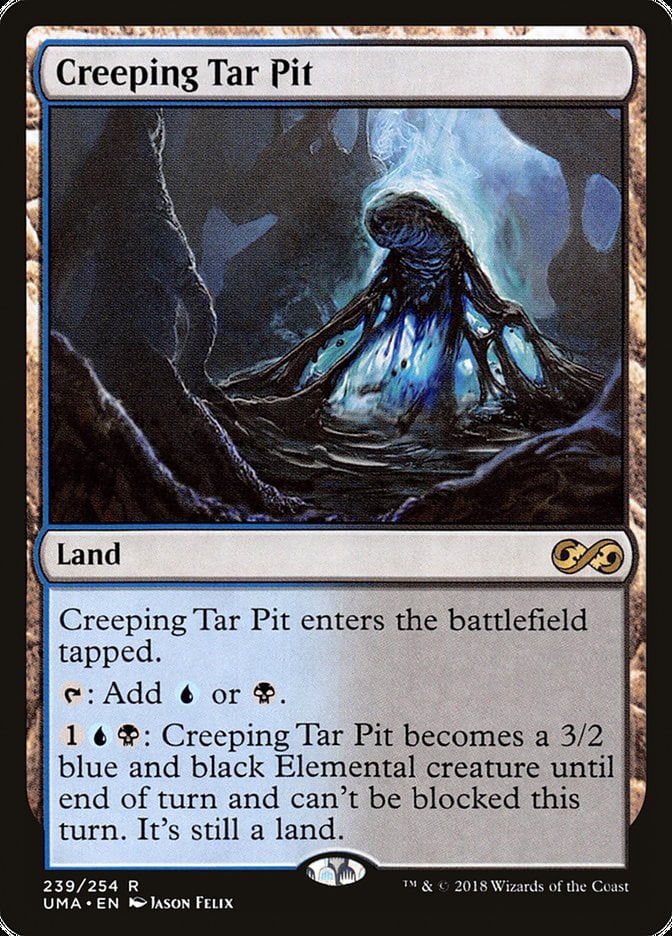
Creeping Tar Pit is a “manland” or “creature land” in MTG lingo: lands that have the ability of turning themselves into creatures.
Entering the battlefield tapped is not ideal, but being unblockable makes Creeping Tar Pit a pseudo-burn effect that comes in handy in long games.
#39. Ice Tunnel
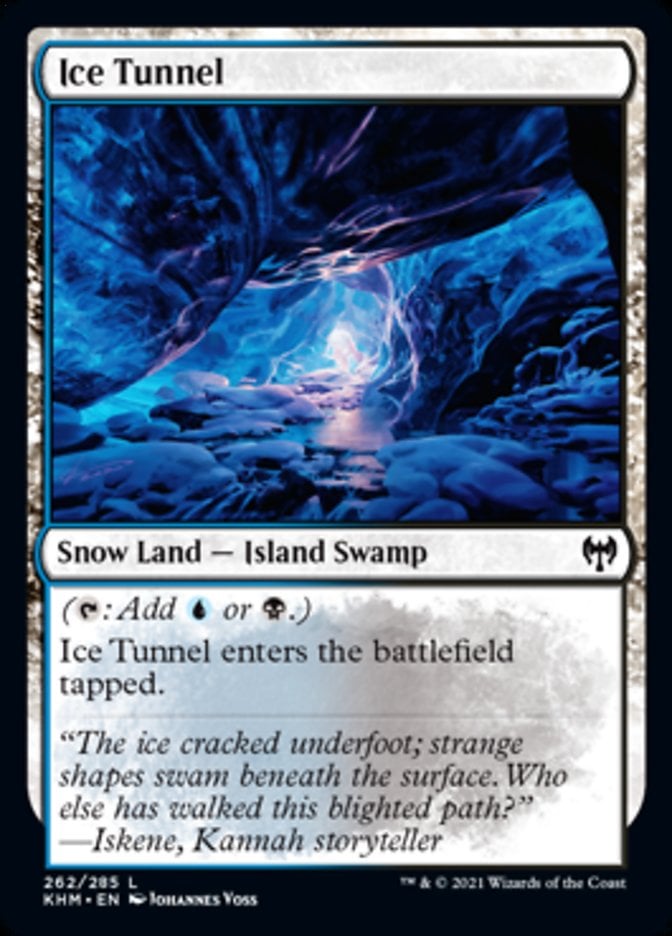
Ice Tunnel has a niche role, but it's very popular in that niche: part of the mana base for Jorn, God of Winter decks. It's also very popular as a single copy in Pauper Dimir Terror decks.
Since Ice Tunnel is both an island and a swamp, we can put it into play with a fetch land.
#38. Fallen Shinobi

Although Dimir is one of Ravnica's guilds, it's a creature type from Kamigama that best embodies Dimir's modus operandi: ninjas.
Fallen Shinobi is among the best of the lot and provides us with a card that’s similar to Thief of Sanity (we get to skim off our foe's library whenever it deals combat damage) but with the ninjutsu twist: Any of our attackers could be swapped for Fallen Shinobi. And in this case, we can cast the pilfered cards without paying the mana costs, which is huge.
Very often seen under Yuriko, the Tiger's Shadow‘s command, Fallen Shinobi is great for putting our opponents into tough spots, forcing them to go out of their way to block our small or elusive threats.
#37. Hostage Taker

Ossification, but in good Dimir fashion you get to cast the exiled card!
Hostage Taker is yet another twist in 's fondness for turning our foe's threats against them. Note that if we cast the exiled card, we'll control the permanent even if our Hostage Taker leaves the battlefield.
#36. Fetid Pools
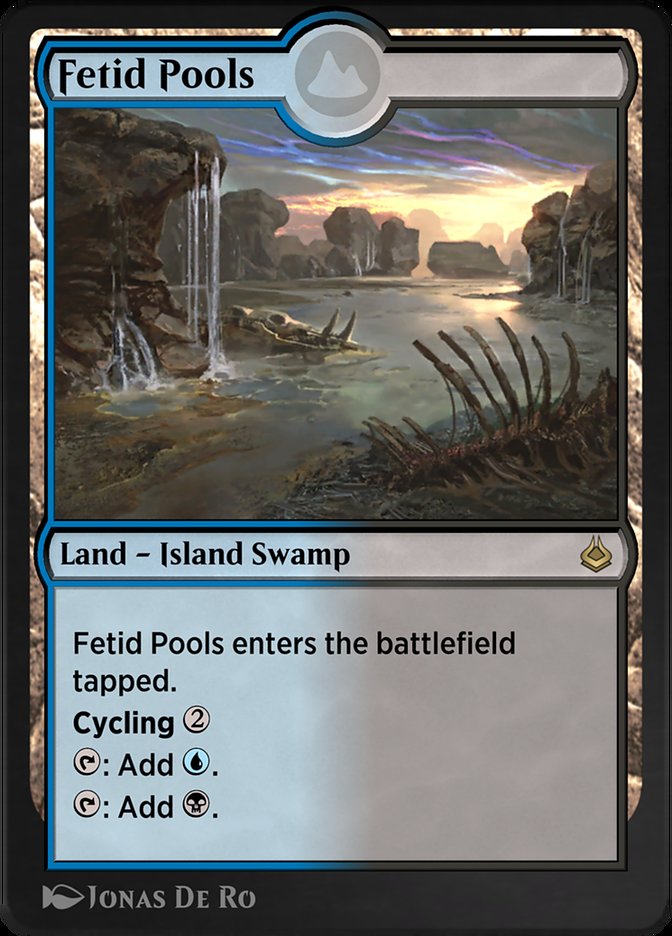
The cycling ability on Fetid Pools is excellent in the late game and offsets these pools' pesky tendency to enter the game tapped.
Also note that Fetid Pools has the island and swamp land types, meaning that we can search for it with fetch lands.
#35. Diregraf Captain

A captain by formal rank but a lord in spirit, Diregraf Captain not only pumps your other zombies but turns them into walking explosives.
#34. Lim-Dûl's Vault

Lim-Dûl's Vault is one of the best ways to dig through your library and find the cards you need. Not as efficient as something like Vampiric Tutor, but a very good alternative that also lets you arrange your next few draws.
Note that every time you pay 1 life, Lim-Dûl's Vault lets you put the 5-card batch on the bottom of your library and look at the next five cards. That's to say, by paying 3 life you can dig 15 cards down, and keep the last five on the top of your deck in any order.
#33. Consuming Aberration
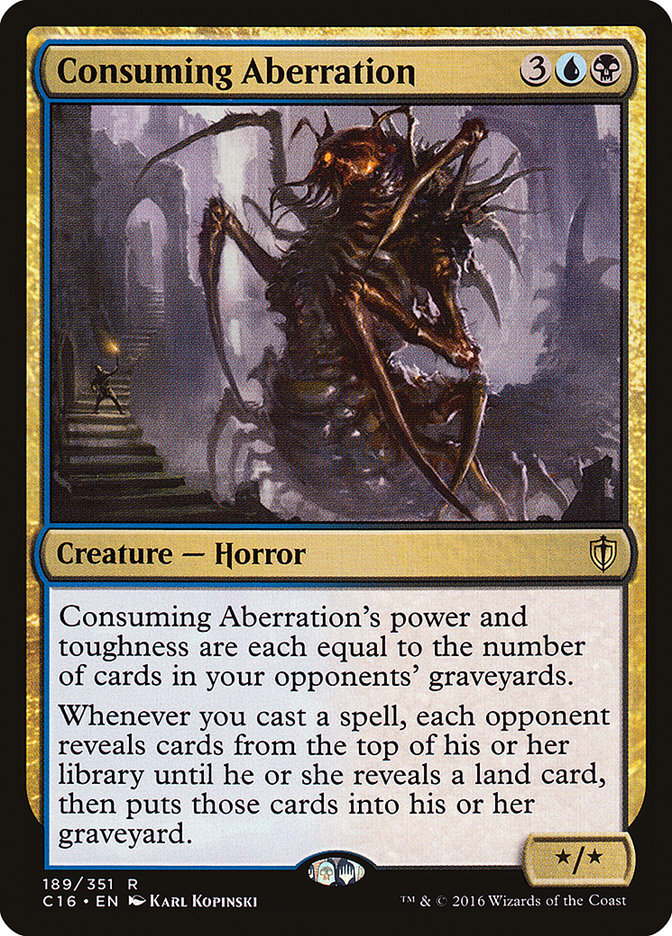
Consuming Aberration lacks Dimir's usual subtlety, but sometimes all you need to get the job done is something big and scary. And Consuming Aberration is plenty scary!
The first part of is quite straightforward: Our Aberration gets bigger the more crowded our opponents' graveyards are, which works very well with Dimir's tendency for milling its foes.
The second part is what makes Consuming Aberration stand out, though: Every time we cast a spell we mill all of our foes at the same time with an ability that doesn’t target.
#32. Mistvault Bridge
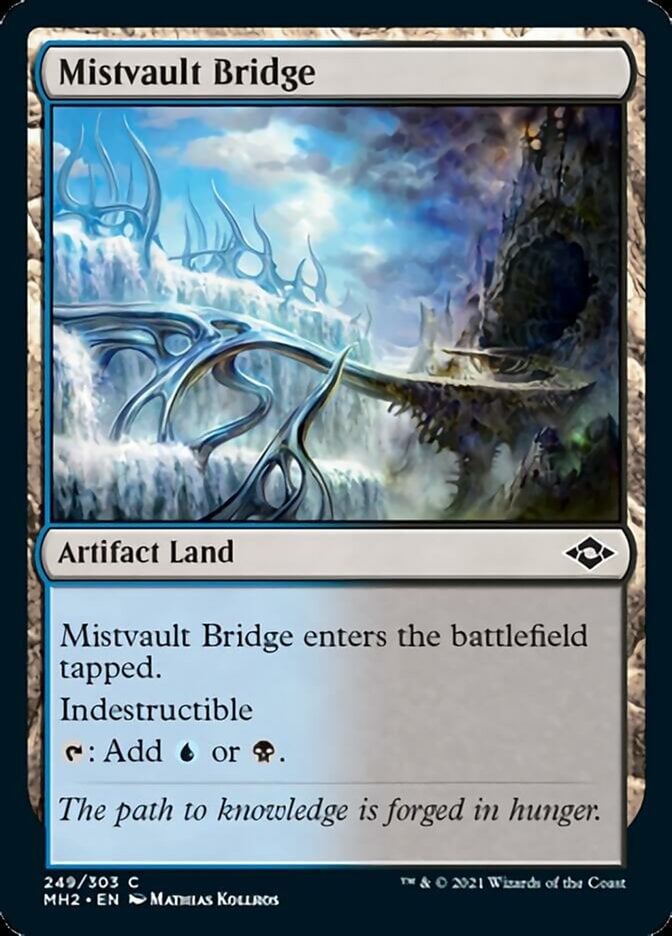
Mistvault Bridge is an artifact land, so decks that care about artifacts and include cards like Tezzeret, Master of the Bridge will be happy to include it.
As a plus, Mistvault Bridge is an indestructible land; it's safe from most artifact or land hate that your opponents may have.
#31. Ashiok, Dream Render
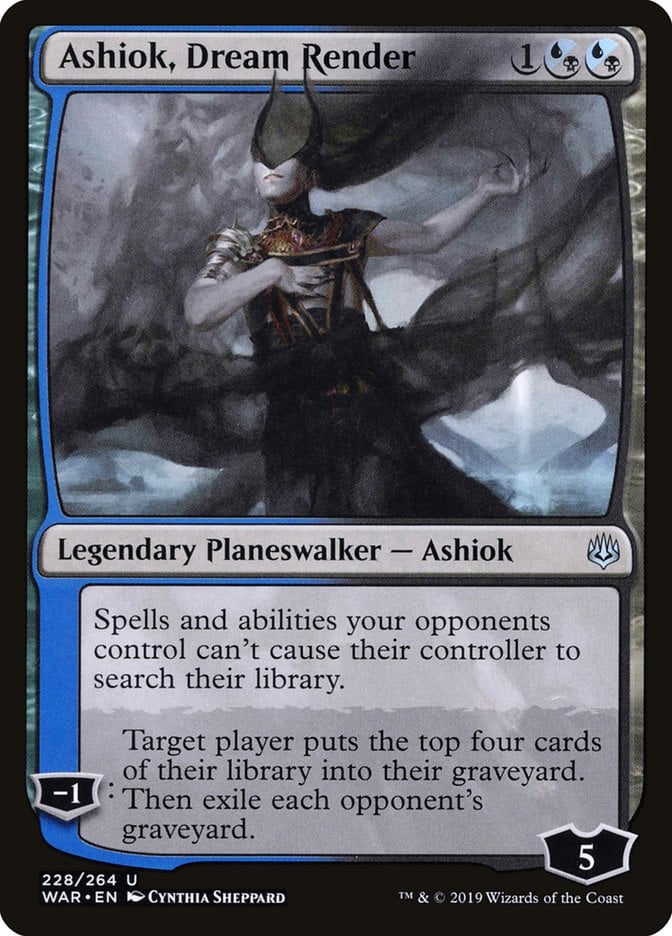
Rather than providing some incremental advantage, Ashiok, Dream Render shuts down anything that searches through our foe's library, from ramp spells and fetch lands to tutor effects.
Ashiok, Dream Render is a fairly popular tech card for Pioneer and Modern sideboards, and in Commander it plays very well with Umbris, Fear Manifest.
#30. Dimir Guildgate

Dimir Guildgate is low-key one very flexible land – while none of the decks that play it are the biggest stars of their respective formats, Dimir Guildgate sees play in Pauper as part of Dimir Terror decks, in Pioneer and Arena's Historic format as part of Gate Control decks, and it's fairly popular in Commander brews.
#29. Drown in the Loch
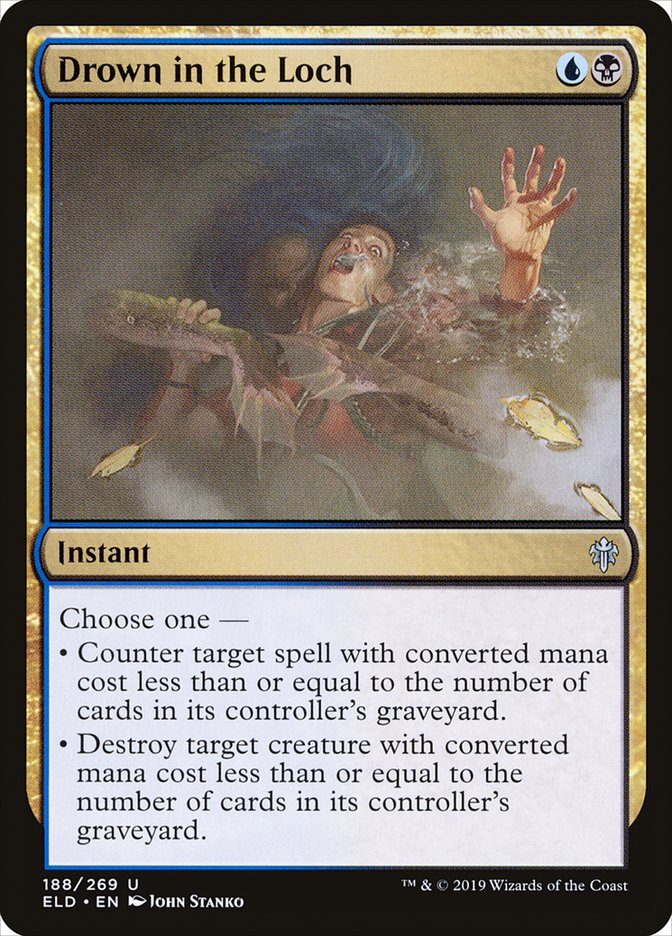
Whether in need of killing something off the board or sniping it while on the stack, Drown in the Loch’s got you covered.
Drown in the Loch becomes more and more powerful the longer the game goes and shines in Dimir EDH decks that plan to mill their foes, such as those under Captain N'ghathrod’s command.
#28. Notion Thief
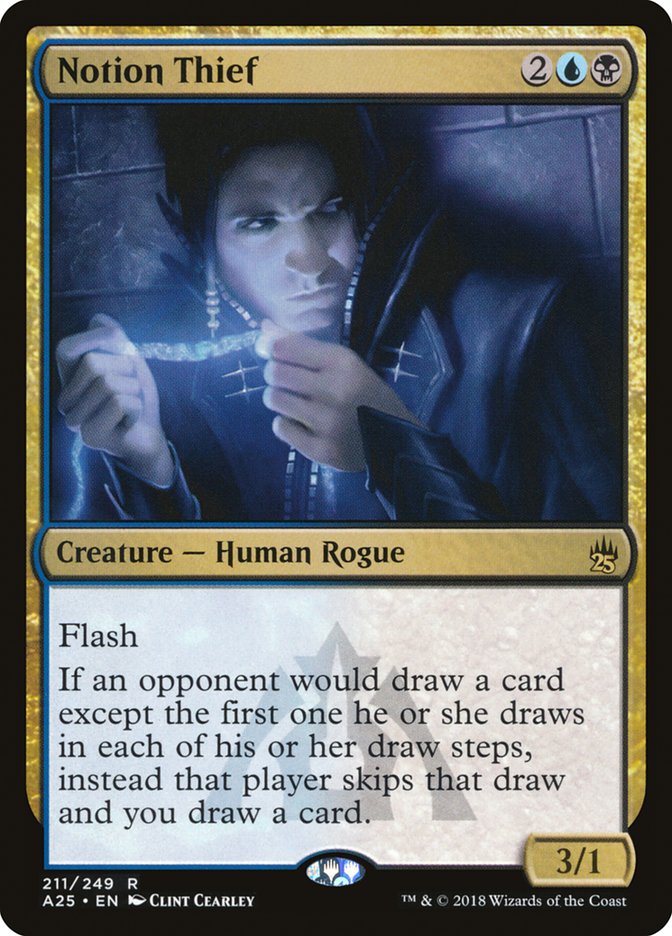
One of the best rogues in MTG, Notion Thief is back-breaking against any deck that plays a big card-draw spell by hammering home Dimir's “what's yours is in fact mine” motto.
#27. Tainted Isle

Unlike many of the Dimir lands we've seen thus far, Tainted Isle always enters the battlefield untapped. You'll need to set things up a bit before it truly becomes a Dimir land but it's a fairly easy hoop to jump through. Remember that several of the dual lands like Fetid Pools or Ice Tunnel are also swamps.
#26. Choked Estuary
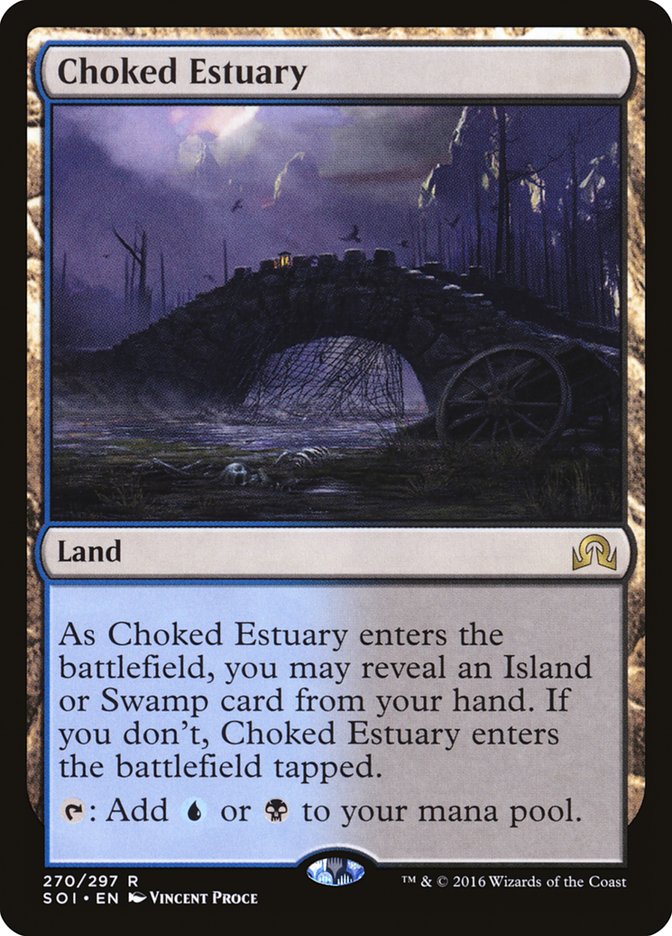
“Reveal lands” are a cycle of dual-color lands that require you to reveal specific land types from your hand if you want them to enter untapped.
In Choked Estuary‘s case, that's either a swamp or an island. It doesn't have to be a basic land: any land that’s either a swamp or island will do, so cards like Fetid Pools fit the bill here.
#25. Baleful Strix
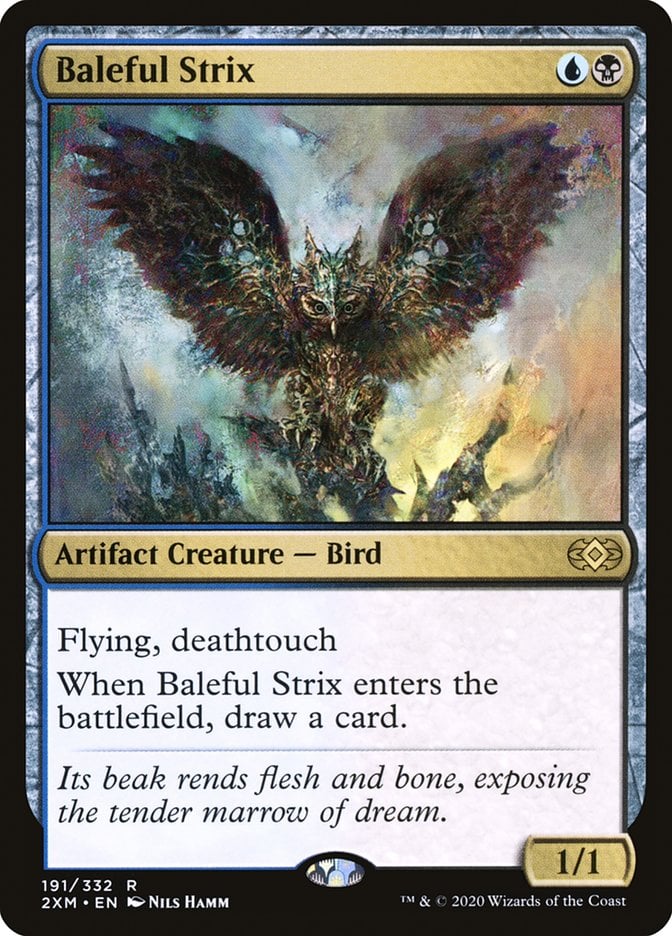
The cantrip-of-death bird, Baleful Strix, is an amazing 2-drop for Dimir decks: One of those cards that’ll never flat-out win you the game, but will always come in handy.
It's also an artifact, offering synergies with the likes of Tezzeret, Master of the Bridge.
#24. Drowned Catacomb
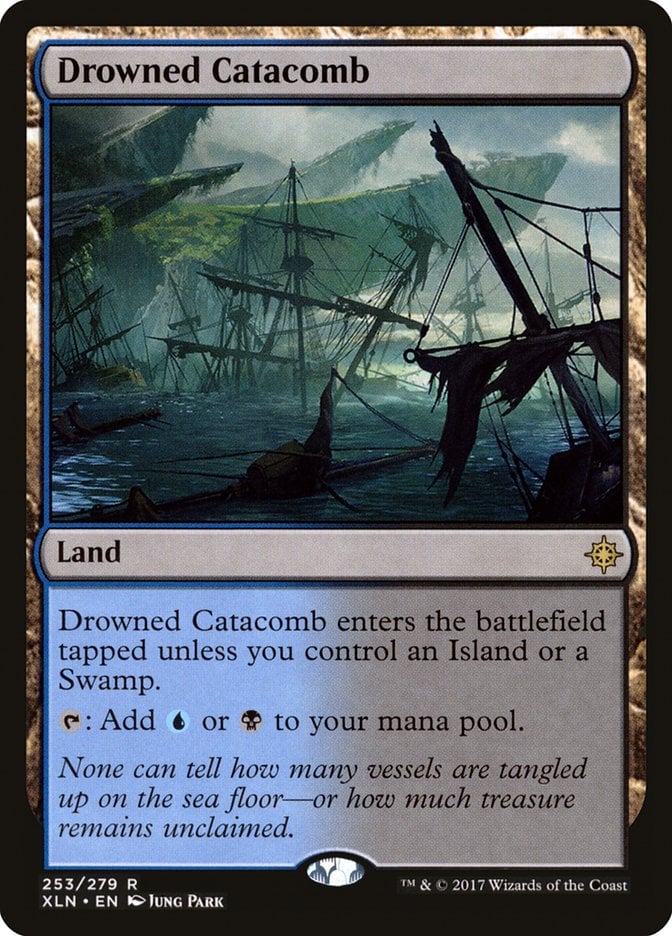
Drowned Catacomb is the Dimir “check land“: lands that enter untapped if you control a land of a specified type.
As usual with these requirements, remember that Drowned Catacomb is happy with any land under your control with the island or swamp type – it doesn't have to be a basic land, so cards like Ice Tunnels will do.
#23. Silas Renn, Seeker Adept
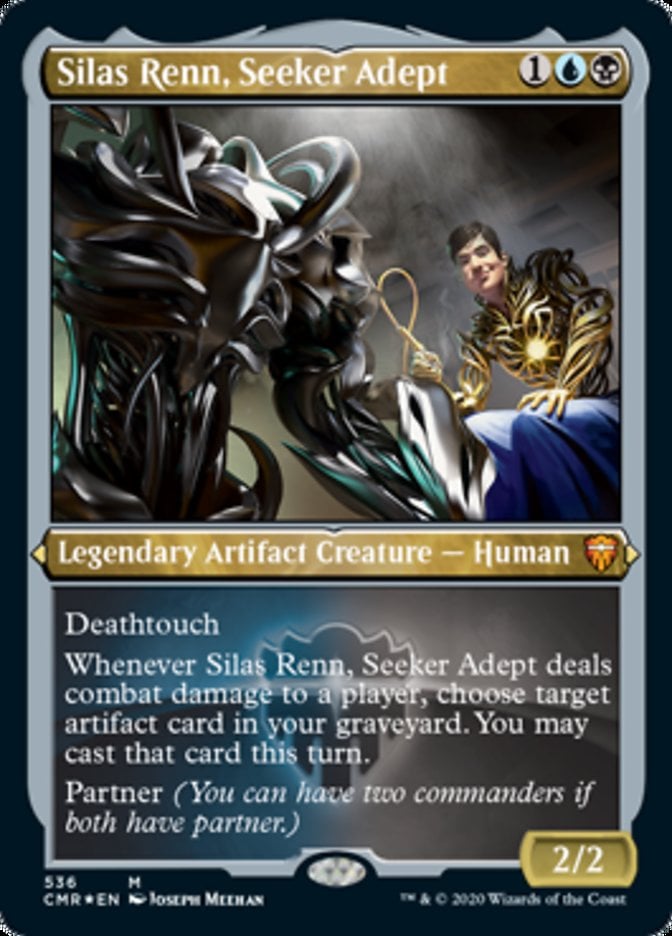
Silas Renn, Seeker Adept is indeed a Dimir card, and a powerhouse in competitive Commander. But neither as a commander themself, nor as part of the regular 99ers: Silas Renn shines when partnered with Rograkh, Son of Rohgahh in decks. These decks often send Rograkh, Son of Rohgahh to fuel effects like Culling the Weak to work towards Ad Nauseam.
As long as you don't mind a bit of on top of your , Silas Renn, Seeker Adept is a top choice for a competitive EDH deck!
#22. Sunken Hollow

Sunken Hollow is fairly similar to Shipwreck Marsh, the crucial difference being that Shipwreck Marsh asks you to have any two lands to enter play untapped, while Sunken Hollow demands you to have two basic lands, which is much harder to fulfill.
Sunken Hollow does have an upside, though: it is itself both an island and a swamp. This means that we can search for it with a fetch land, and Sunken Hollow will fulfill the requirements for Drowned Catacomb or Choked Estuary.
#21. Temple of Deceit
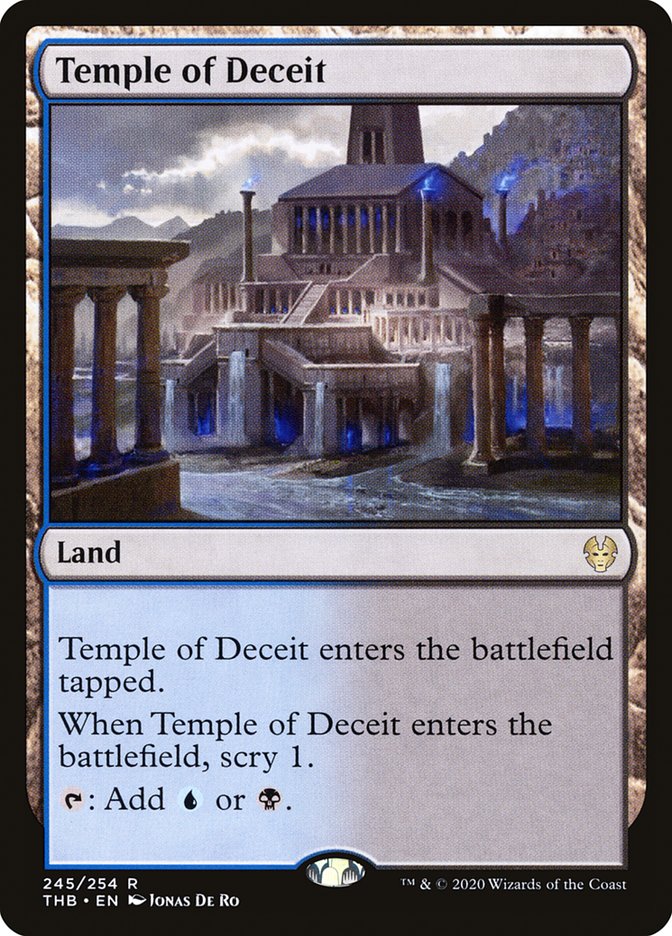
Introduced in Theros, “scry lands” are what you'd expect for lands with such a nickname: They let you scry when they enter the battlefield. Temple of Deceit is the Dimir representative of this group.
Scrying is of course always a nice effect, and it shines with commanders like Wilhelt, the Rotcleaver that have easy access to card draw.
#20. Umbris, Fear Manifest
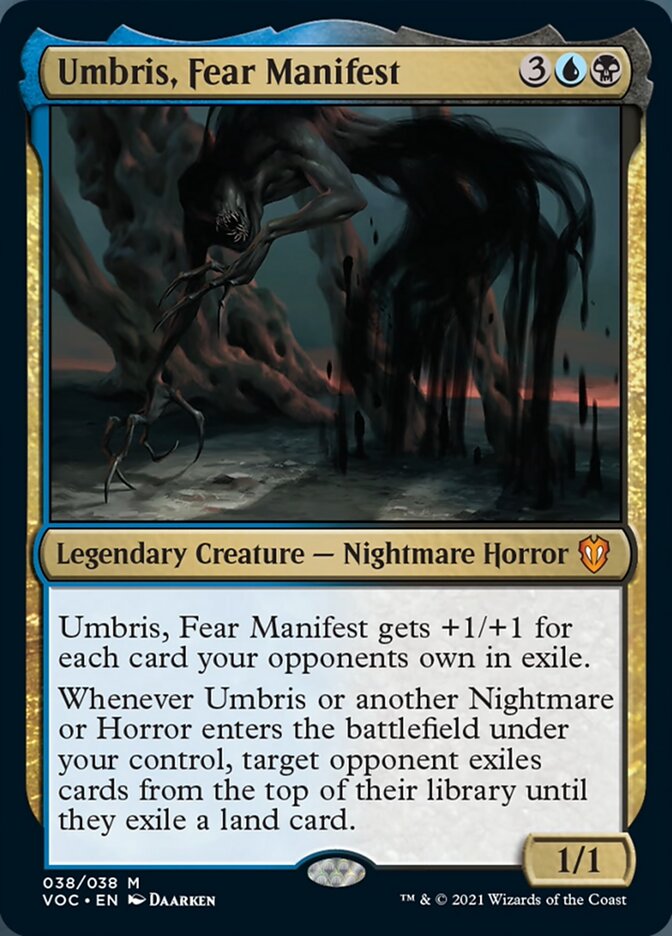
Umbris, Fear Manifest is one of the best horror commanders in MTG. It works nicely with Ashiok, Dream Render and other cards that exile our opponent's cards, like Leyline of the Void. But Umbris, Fear Manifest isn’t afraid of doing the heavy lifting itself by exiling from an opponent's library every time you play a horror or nightmare.
Black is known to be willing to pay any cost for power. In Umbris, Fear Manifest‘s case that would be about $8-$10, since it’s only been printed in Crimson Vow Commander.
#19. Clearwater Pathway / Murkwater Pathway
Technically speaking, Clearwater Pathway and Murkwater Pathway are single-color lands. But since you can choose which face to play, you can pick whichever color you need the most.
Such flexibility comes with a price: While previous lands we've seen cost just a few cents, you'll need to pay $4-$5 per copy of Murkwater Pathway.
#18. Anowon, the Ruin Thief
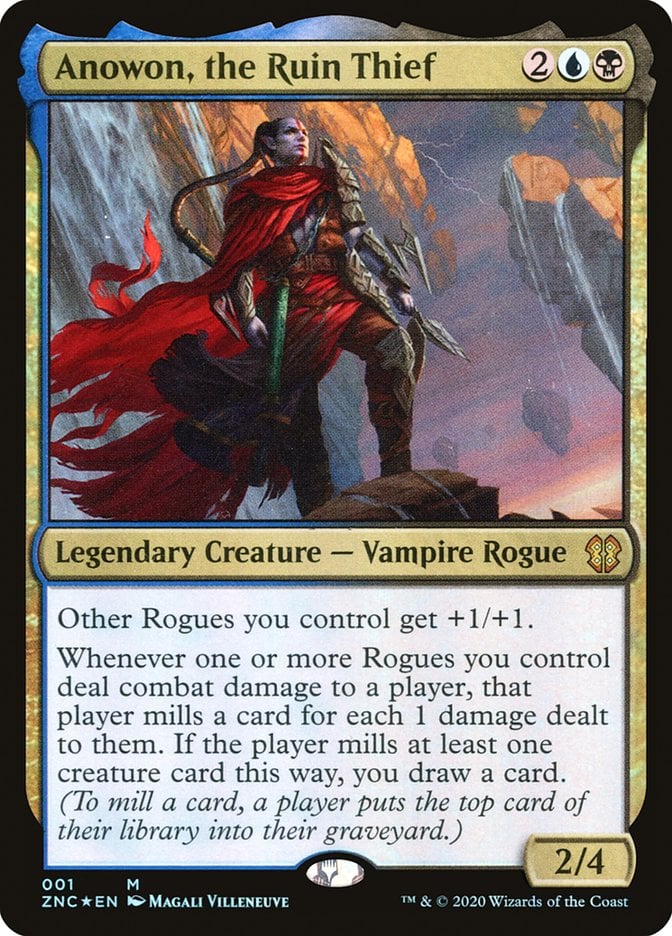
Lord effects are often enough to make a card worthy of consideration. Anowon, the Ruin Thief also turns your rogues into milling saboteurs and fuels your “opponents' graveyards matter” effects like Consuming Aberration.
Anowon, the Ruin Thief also provides us with Dimir's usual incremental advantage, but this time with a sort of Curiosity effect rather than letting us cast our enemies' spells. Note that you draw only one card regardless of how much damage your rogues deal to a player, though the ability triggers once per player dealt damage.
Anowon, the Ruin Thief sees nearly zero play outside of EDH, but in the multiplayer format it’s among the top 100 most popular commanders in any color combination, and close to top 5 among Dimir commanders.
#17. Dimir Aqueduct
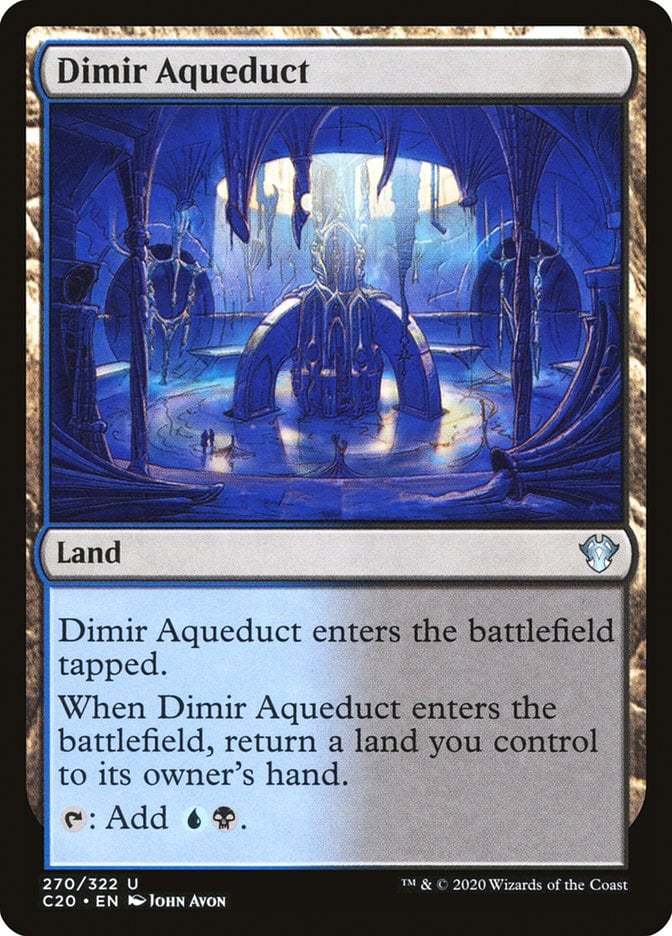
There are hoops to jump here, chief among them the fact that if you play Dimir Aqueduct as your first land then you'll have to bounce it back to your hand. And it enters the battlefield tapped, which is never a good thing…
… but past those hoops lies a 2-mana land that’ll push you toward whatever Dimir plot you're scheming!
#16. Wilhelt, the Rotcleaver

Shambling zombies, and a commander that loves sending fodder to their slaughter – name a more iconic duo!
Wilhelt, the Rotcleaver is one of the most popular commanders of any color combination, and the second most-popular in Dimir. The reason it’s not ranked higher is because Wilhelt sees no competitive play in any format (EDH included), but a zombie commander that can both generate sacrifice fodder and provide a sacrifice outlet for said fodder offers a lot of flexibility for casual decks.
#15. Darkwater Catacombs

Darkwater Catacombs provides excellent mana fixing and comes into play untapped. You do need another source, but as long as you can create mana of any color you pay one and get back two. An excellent deal!
#14. Darkslick Shores

Darkslick Shores is Dimir's version of a fast land: dual-color lands without any drawback as long as you play them early in the game.
Darkslick Shores is the sort of card that you love to find in your opening hand. It's extremely popular nowadays in Standard, usually in Esper decks.
#13. Captain N'ghathrod
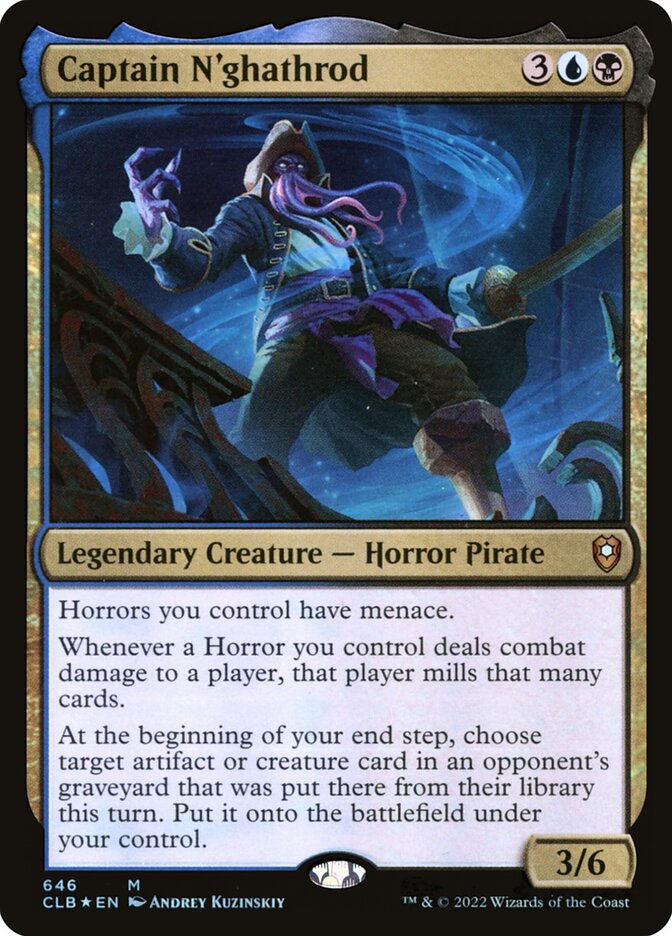
If you want a horrific EDH deck, Captain N'ghathrod is your slam-dunk commander of choice. They buff your other horrors and turns them into horrifying thieves, also cheating mana in the process. Enough to turn any foe into Colonel Kurtz as you steamroll them!
#12. Shipwreck Marsh
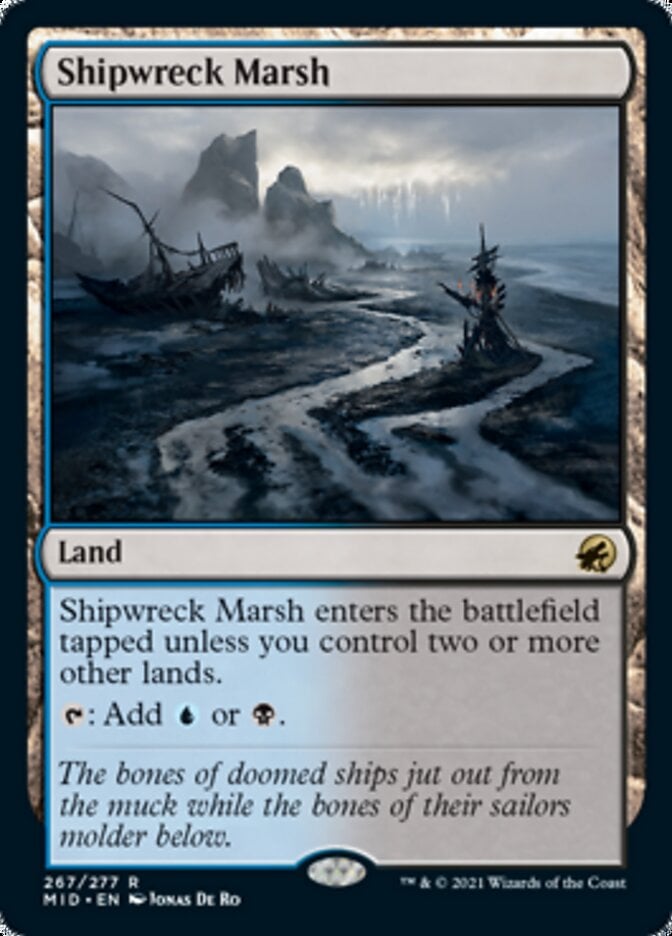
“Slow lands“, as the nickname implies, are the opposite of “fast lands”: these come into play untapped if you control two or more (rather than two or less) lands. Shipwreck Marsh is the Dimir representative.
Slow lands are not ideal for decks that want to play fast, but this color pair tends to enjoy longer, grindier games, so cards that like taking it slow are rarely a problem. In fact, since decks tend to have a lot of counterspells, they need to be able to play their lands untapped in the late-game, to “keep their shields up” – in those scenarios, a slow land is better than a fast land.
#11. Satoru Umezawa
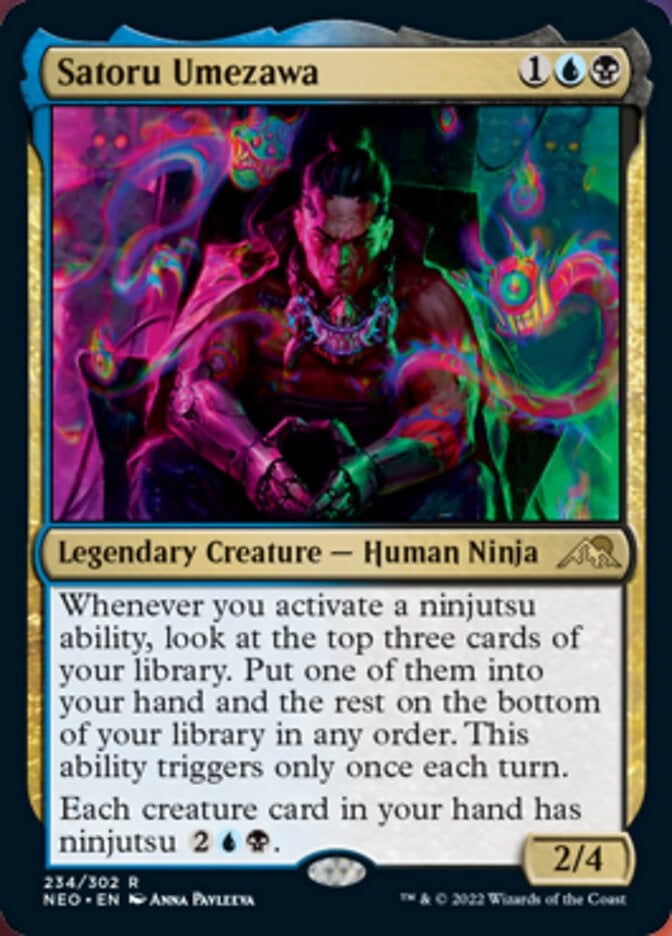
If you've watched one too many episodes of Naruto and wished you could run your own Ninja school… well, now you can!
Satoru Umezawa loves it when you fill your deck chock-full of ninjas; in that scenario, they provide a good amount of card filtering every time you activate a ninjutsu ability.
But Satoru's main trick is turning everybody else into rookie ninjas, letting you cheat huge threats just by paying . Load your deck with cheap and evasive threats like Slither Blade or Siren Stormtamer, sprinkle with the biggest Eldrazi bombs you have in stock, and just let Satoru Umezawa teach your foes what “cheap trick” really looks like.
#10. Underground River

As old as Ice Age, the allied “pain lands” will ping you every time you tap them for colored mana. But always entering untapped and giving you the mana you need on turn one is an excellent perk, above all in commander games given the larger life cushion that players have in that format.
As with other Standard-legal Dimir lands, Underground River is a must-include in Esper lists, which at the moment of writing is arguably the best deck in the format.
#9. Talisman of Dominance
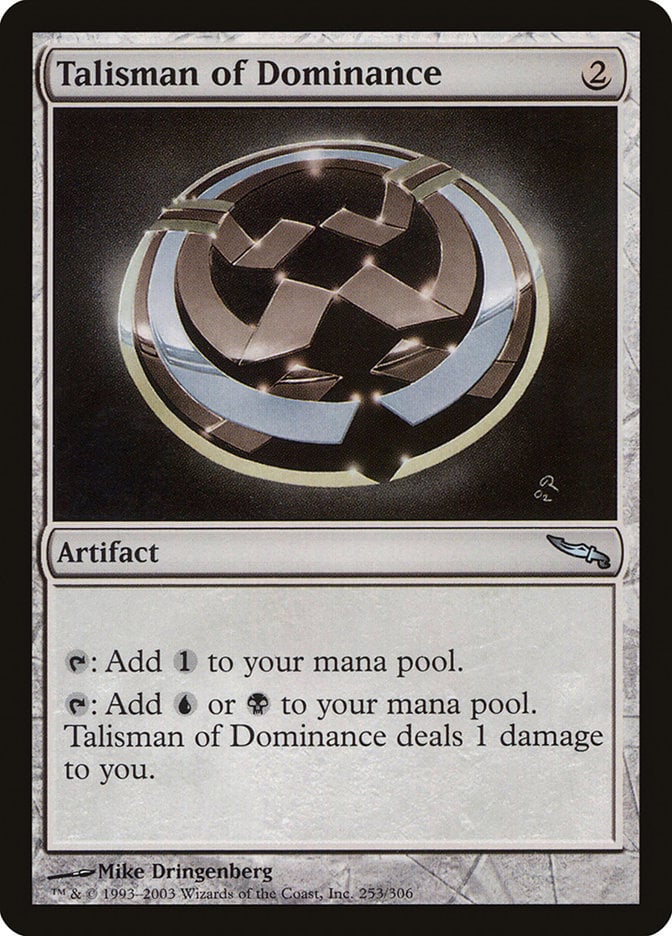
Lands are obviously crucial to any MTG deck, but you'll often need some extra juice. Mana rocks are the most common way to squeeze that extra bit of mana to cast your big spells ASAP, and Talisman of Dominance is literally Underground River in artifact form.
#8. The Scarab God
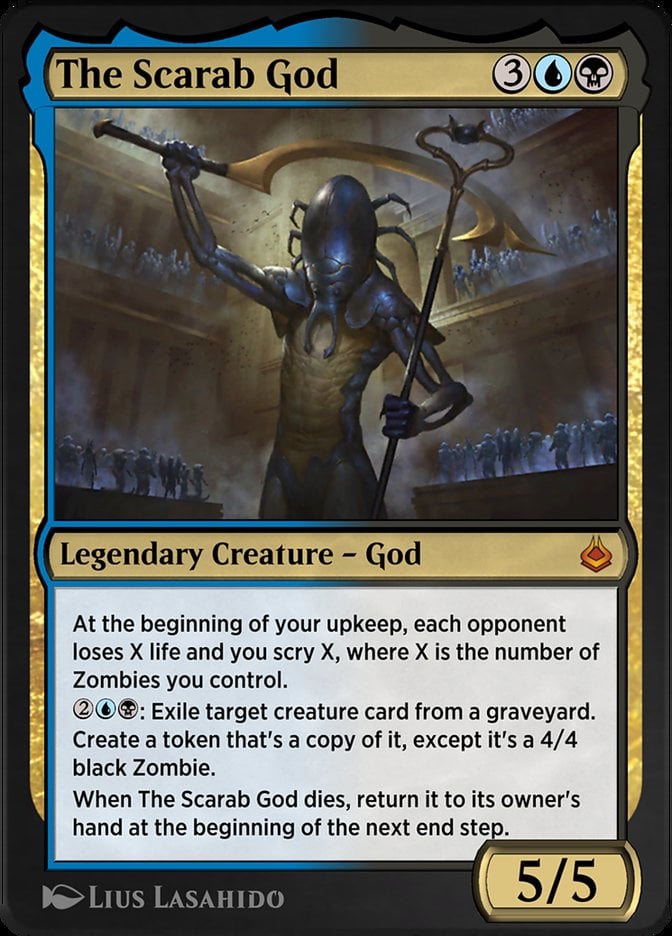
Speaking of zombies, The Scarab God is a very flexible option for all your zombifying needs: One of the most popular Dimir commanders, an excellent team player as part of your 99ers (often letting Wilhelt, the Rotcleaver take the wheel), and as of late with some showings in major tournaments in Pioneer, Explorer and Historic.
Graveyard hate (its activated ability can target any graveyard), card selection, recursion, life loss… The Scarab God has it all. Oh, and it's nigh-impossible to kill for good!
The only thing this bug-headed deity can't offer you is a cheap deal: A Commander Masters reprint has managed to drive The Scarab God‘s price a bit below $8-$9 but that's as low as it goes, and most other versions are a lot more expensive.
#7. Dimir Signet

Dimir Signet’s no Arcane Signet. But as long as you have any other mana source lying around, Dimir Signet does such a good impersonation that it might just as well be!
#6. Morphic Pool
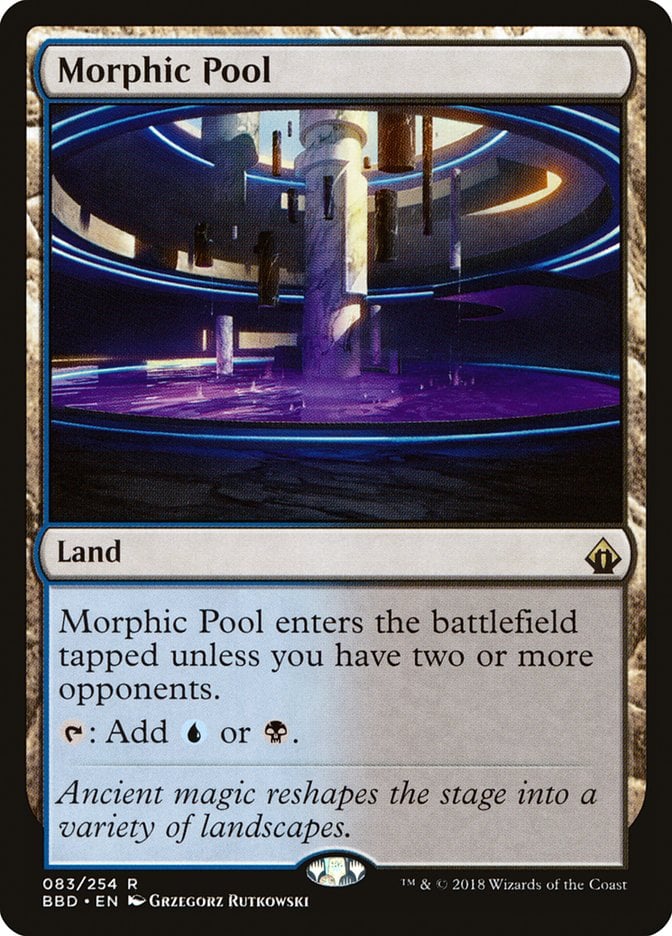
If you're playing Commander, Morphic Pool is among the best Dimir lands in MTG. The only reason we'll find better-ranked lands in today's list is that Morphic Pool is pretty mediocre in 60-card formats.
It's also the first card in today's ranking that costs above $10: Depending on the version, you should expect to pay $12-$15 per copy.
#5. Toxrill, the Corrosive

Toxrill, the Corrosive is another horror commander, although unlike Captain N'ghathrod it doesn't care too much about other horrors in your deck.
That doesn't stop Toxrill, the Corrosive from being a very versatile commander even in competitive settings, a very popular 99er, and able to make some forays into Pioneer and Standard.
Toxrill, the Corrosive‘s abilities provides a form of slow-burn board wipe that can do double duty as sacrifice fodder and card draw; notice that Toxrill creates a 1/1 slug whenever a slimed enemy creature dies for any reason, not just when the slime counters kill it.
#4. Sunken Ruins
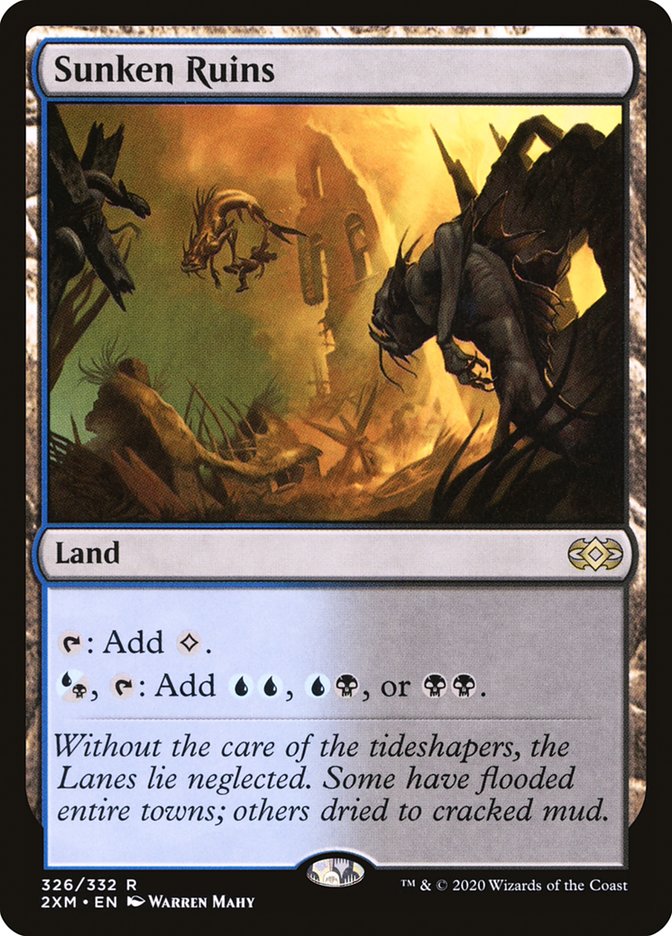
A Modern staple and fairly common in competitive EDH decks, Sunken Ruins needs a bit of setting up but provides some excellent mana fixing once you have it running at full steam.
#3. Watery Grave
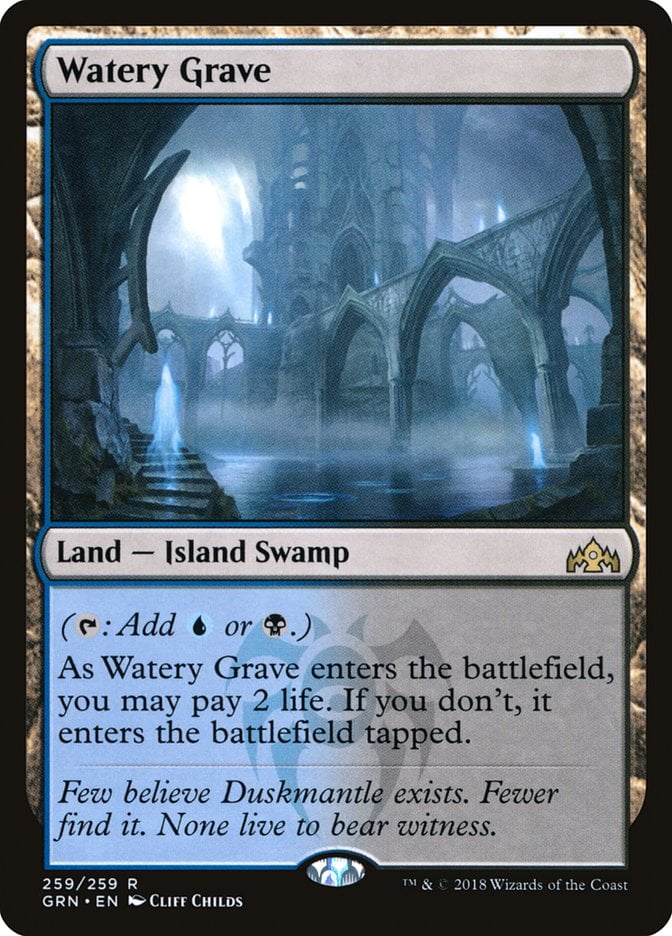
One of the famous “shock lands” (nicknamed that way because playing them untapped is akin to Shocking yourself) Watery Grave is arguably the second-best Dimir land in MTG.
Watery Grave will enter untapped in the early game, and later you can always play it tapped if you prefer. As the cherry on top it's both an island and a swamp: fetchable with fetch lands, and fulfills the requirements of other lands that want islands or swamps on board or in hand.
Shocks ain't cheap, by the way: Expect to pay about $11-$13 per copy.
#2. Yuriko, the Tiger's Shadow

Yuriko, the Tiger's Shadow is the fourth most popular Commander in the entire format, and has made some successful forays into Legacy.
Yuriko comes with a special variant of ninjutsu called “commander ninjutsu” that can be activated from the command zone: Since commander ninjutsu isn't the same as casting Yuriko as a spell, you don't need to pay the commander tax in this case, and playing Yuriko via ninjutsu won't increase commander tax to pay later.
In short, Yuriko, the Tiger's Shadow will keep coming back for 2 mana, no matter how many times you think you've killed them.
And, needless to say, that second skill is devastating: Life loss to all other players plus card draw every time one of your ninjas connects will make quick work of any foes that cross Yuriko's path.
#1. Underground Sea

Sometimes simple is best.
Coming all the way from Alpha, Underground Sea is one of the original dual lands. Comparing it side by side with Underground River or Watery Grave makes it clear, even at a glance, why Underground Sea is so good: a simple dual-colored mana source, no strings attached, no drawbacks, and it’s also both an island and a swamp.
That simple difference makes Underground Sea so good that it's a staple even in Vintage, the highest-powered format in all of MTG.
On the other hand…
… Underground Sea costs more than all of the other cards in this ranking combined… and multiplied by six!
Simple, effective, nothing flashy about it: If your deck wants the best Dimir card in the game, Underground Sea would be it.
Best Dimir Card Payoffs
“Dimir cards” is so wide a category that we can’t really talk about “Dimir payoffs” other than pointing out the obvious: you get to play Dimir cards.
On the other hand, a Dimir deck doesn’t need to be composed entirely of Dimir cards. Most Dimir decks will have lots of black or blue cards, and those will tend to be the deck's win condition. Culling the Weak, Ad Nauseam, Rhystic Study and Thassa's Oracle, for example, are among the strongest cards in Commander, and Dimir decks have access to all of them.
What Is Dimir Good At in MTG?
In an article about the intricacies of designing MTG cards for the Dimir color pair, Magic's head designer Mark Rosewater wrote: “The thing that ties together blue-black is this sense is that it's getting incremental advantage at every turn. If any color combination is the poster child for the two-for-one, it's blue-black. What this means is that when you build a blue-black theme, you have to figure out how it's getting its incremental advantage.”
Black and blue also have access to a lot of evasive creatures, and Dimir excels at milling and exiling their opponent's library… often putting those cards to better use.
Last but not least, black-blue decks are adept at stopping enemy plans before they can hatch. Blue specializes in neutralizing threats while they are still on the stack (via counterspells). Black specializes in taking care of threats while they’re still in our foe's hands (via forced discards). And Dimir often takes things one step further by stealing enemy threats from the top of their library.
Wrap Up
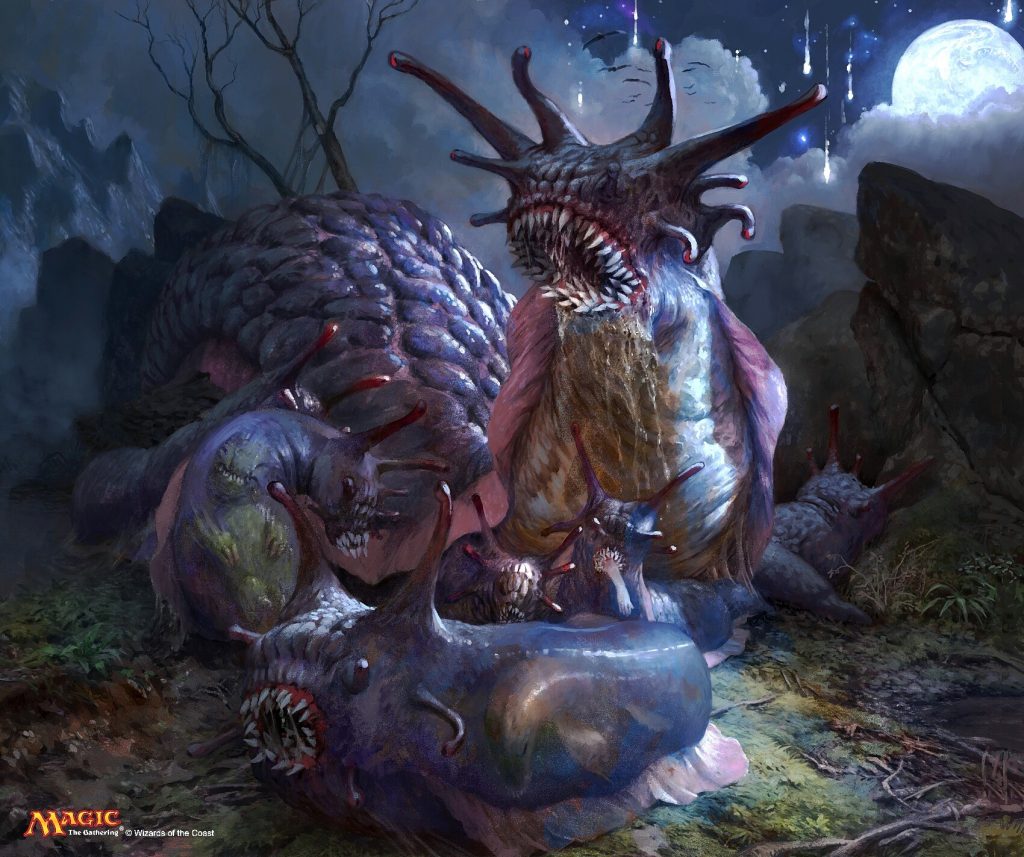
Toxrill, the Corrosive | Illustration by Simon Dominic
And that concludes our ranking of best Dimir cards in MTG. I hope you've found the article interesting and inspiring for your upcoming black-blue plots and schemes.
If you have comments or questions about these rankings, do stop by the Draftsim Discord for a chat or ping me on the social network formerly known as Twitter.
And good luck out there!
Follow Draftsim for awesome articles and set updates: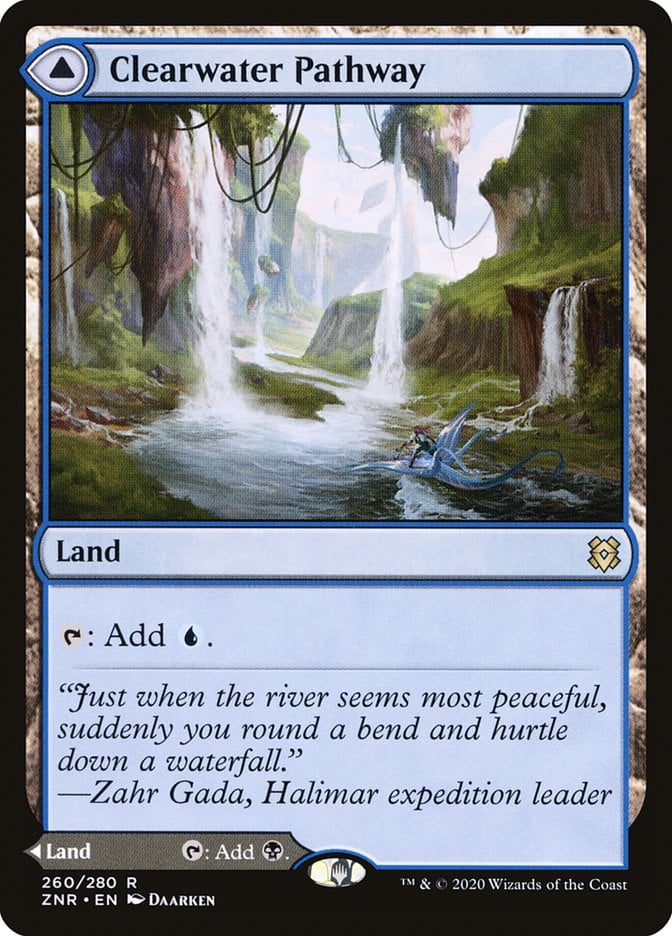

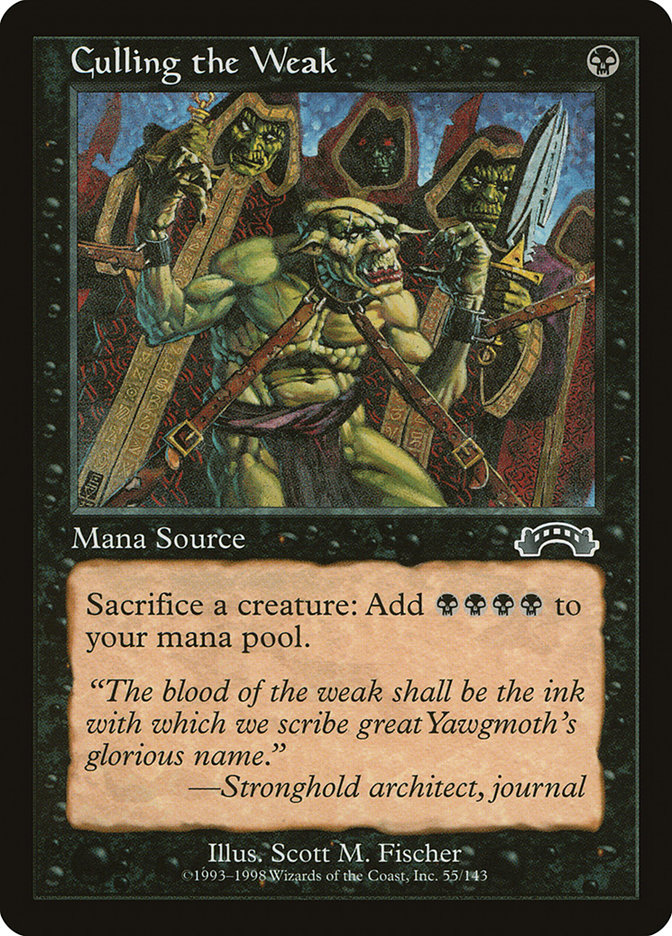
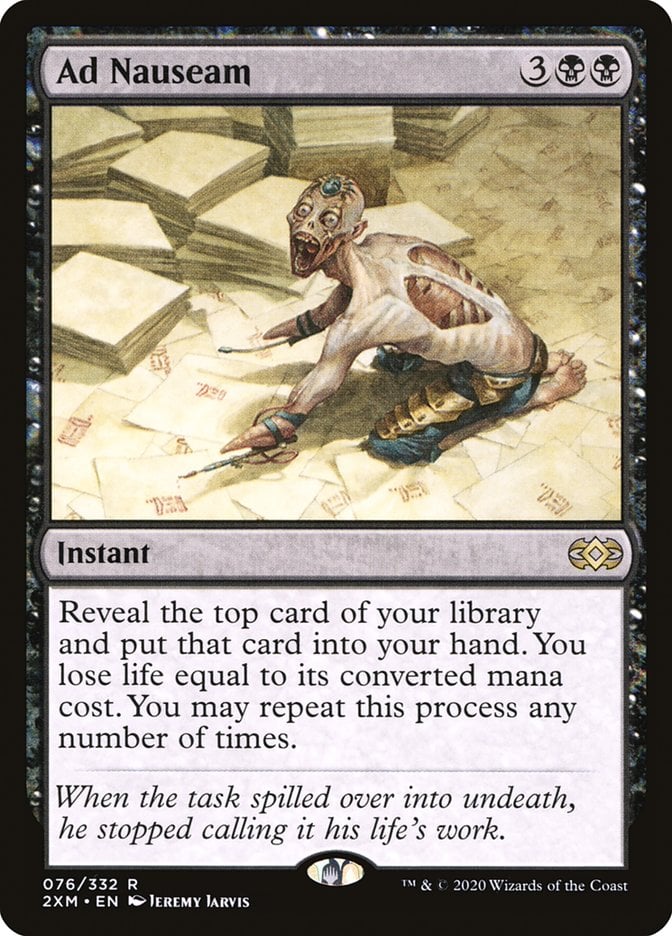
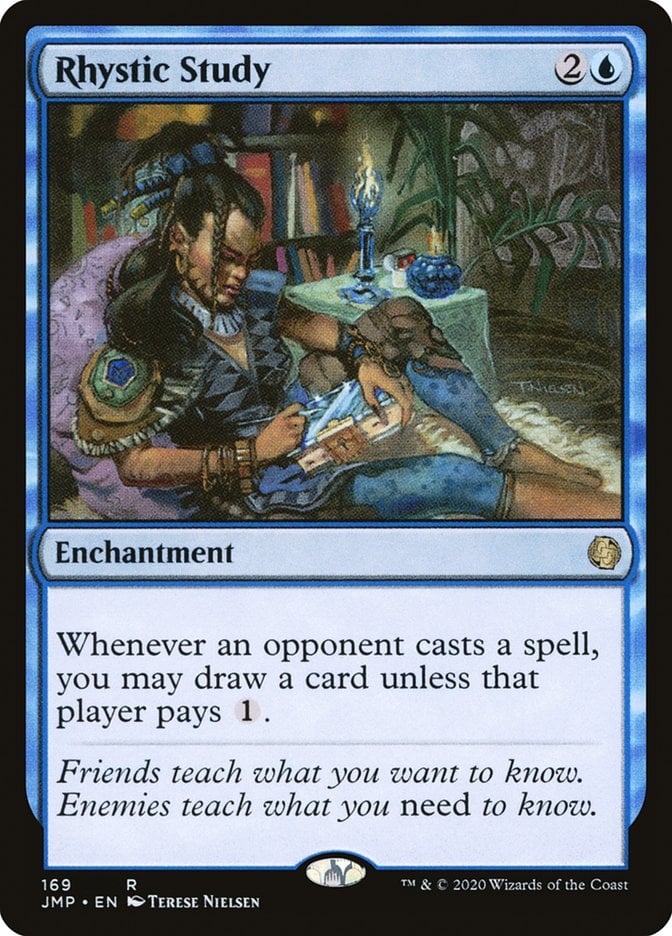
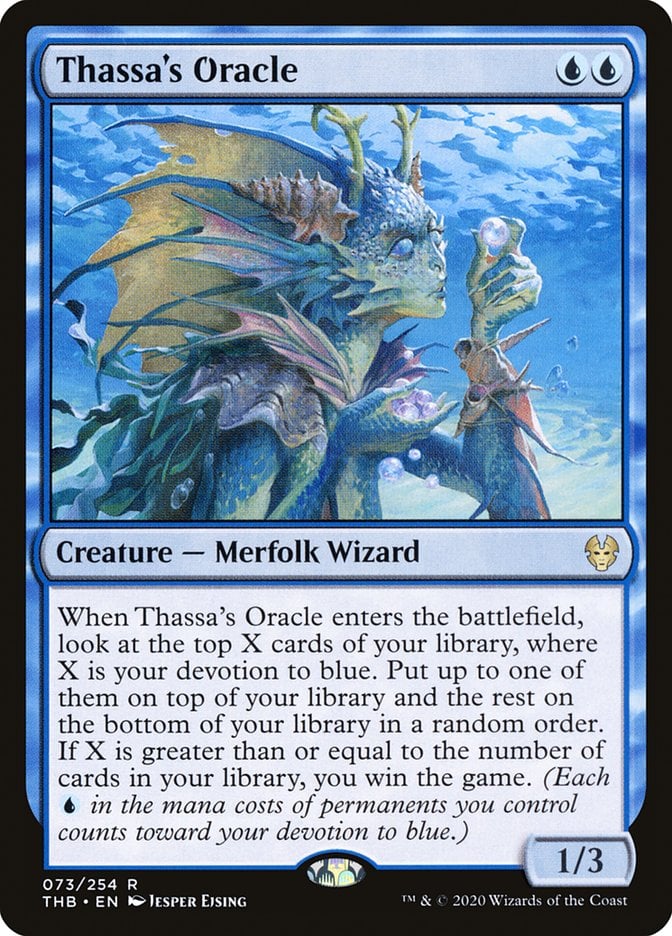
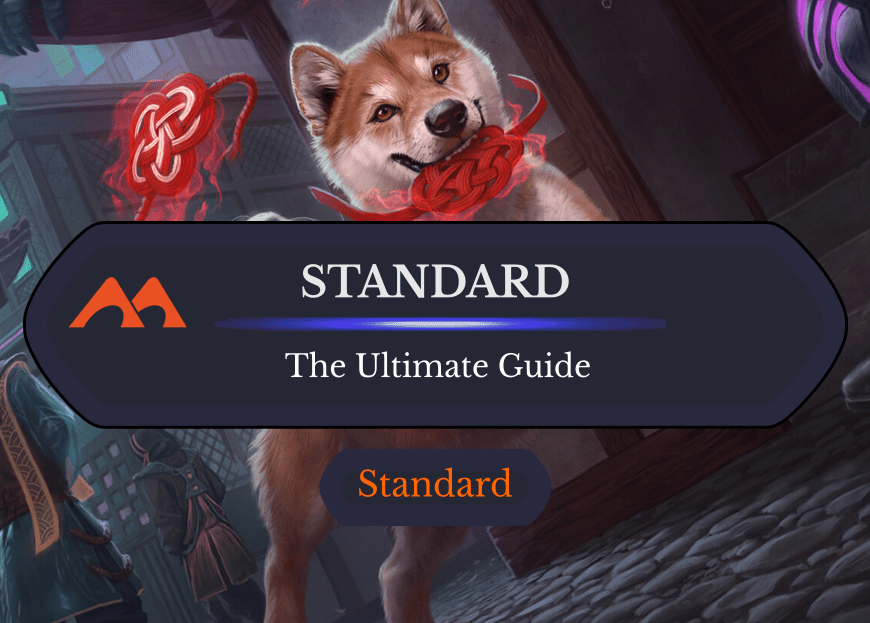

Add Comment